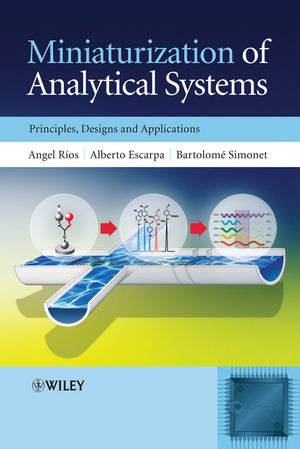Miniaturization of Analytical Systems: Principles, Designs and ApplicationsISBN: 978-0-470-06110-7
Hardcover
384 pages
September 2009
 |
||||||
1 Miniaturization in Analytical Chemistry.
1.1 Introduction.
1.2 Miniaturization as One of the Critical Trends in Modern Analytical Chemistry.
1.3 Evolution in the Field of Analytical Miniaturization.
1.4 Classification of Miniaturized Analytical Systems and Definition of Terms.
1.5 Theory of Miniaturization.
1.6 Features of Miniaturized Analytical Systems.
1.7 Incidences of Miniaturization in the Analytical Process.
1.8 Outlook.
References.
2 Tools for the Design of Miniaturized Analytical Systems.
2.1 Introduction.
2.2 Miniaturized Analytical Processes: The Downsizing and Integrating Phenomena.
2.3 Microfluidic Devices.
2.4 Microtechnology.
2.5 MEMS and NEMS.
2.6 Outlook.
References.
3 Automation and Miniaturization of Sample Treatment.
3.1 Introduction.
3.2 Simplification of Sample Treatment: Microextraction Techniques.
3.3 Simplification of Sample Treatment: Continuous Flow Systems.
References.
4 Miniaturized Systems for Analytical Separations I: Systems Based on a Hydrodynamic Flow.
4.1 Introduction.
4.2 The Earliest Example of Miniaturization of a Gas Chromatograph and Some Other Developments.
4.3 Capillary Liquid Chromatography (CLC).
4.4 Liquid Chromatography on Microchips.
References.
5 Miniaturized Systems for Analytical Separations II: Systems Based on Electroosmotic Flow (EOF).
5.1 Introduction.
5.2 CE on the Microchip Format.
5.3 Modes and Theories of CE Microchips.
5.4 Microfabrication Techniques.
5.5 Basic Fluidic Manipulation/Motivation: Electrokinetic Injection and Separation Protocols.
5.6 Electrochromatography in Microchip Format: Designs and Applications.
5.7 Comparison of Hydrodynamic and Electroosmotic Flow-driven Miniaturized Systems.
5.8 Analytical Applications.
5.9 Outlook.
References.
6 Detection in Miniaturized Analytical Systems.
6.1 Introduction.
6.2 Laser-induced Fluorescence (LIF) Detection.
6.3 Electrochemical Detection (ED).
6.4 Microfluidics–MS Interfacing.
6.5 Unconventional Detection Methods.
6.6 Outlook.
References.
7 Miniaturization of the Entire Analytical Process I: Micro(nano)sensors.
7.1 Introduction.
7.2 Evolution of Sensors with Nanotechnology.
7.3 Micro(nano)sensors.
7.4 Nanoprobes for In Vivo Bioanalysis.
References.
8 Miniaturization of the Entire Analytical Process II: Micro Total Analysis Systems (μTAS).
8.1μTAS, Microfluidics and Lab-on-a-Chip: Concepts and Terminology.
8.2 Basic Concepts of Microfluidics: The Design of Analytical Microsystems.
8.3 The Basics of Downscaling in Microsystems.
8.4 Microfluidic Platforms: Types, Principles and Classification.
8.5 Microfluidic Devices for Analytical Lab-on-a-Chip Applications.
8.6 Outlook.
References.
9 Portability of Miniaturized Analytical Systems.
9.1 Introduction.
9.2 Portable Gas Analysers.
9.3 Portable Electrochemical Analysers.
9.4 Portable Optical Analysers.
9.5 Portable Lab-on-a-Chip Analysers.
References.
10 Analytical Performance of Miniaturized Analytical Systems.
10.1 Introduction.
10.2 Quality Control in Miniaturized Systems.
10.3 Validation of Microsystems.
10.4 Qualification of Microsystems.
10.5 Robustness of Microsystems.
Further Reading.
Index.



